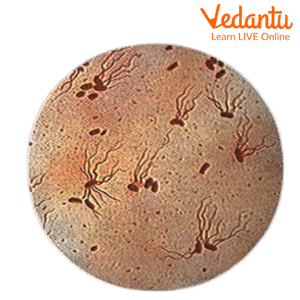




What is Typhoid?
You all might have suffered from a fever. There are many reasons for fever. One of them is Typhoid. Typhoid is an infectious bacterial disease that mainly spreads through contaminated food or water. It can also spread due to poor hygienic conditions. Salmonella typhi is the bacterium responsible for this disease and humans are the only carriers. In the early 1900s, the United States reported its first case of typhoid fever. Approximately 21 million people worldwide contract this illness each year, and 200,000 instances result in death. Now, we are going to see about typhoid in detail. We will cover the topics like typhoid symptoms in kids, why typhoid attacks, and causes of typhoid.

A patient with Typhoid
What Causes Typhoid Fever?
The bacterium Salmonella typhi is what causes typhoid fever. By consuming food or drinking water that has been tainted by a patient or carrier of the sickness, the bacteria can be spread from one person to another. The infected person's stool contains the bacterium.
There is a famous story about typhoid. This story is of a lady named Mary Mallon. Mary Mallon, often known as Typhoid Mary, was an American chef of Irish descent who is thought to have exposed 51 to 122 persons to typhoid illness. With estimations of up to 50 for unconfirmed mortality, the illnesses resulted in three verified fatalities.
Causes of Typhoid
By consuming or drinking infected food or water, one can get typhoid fever. Stool from sick people, which has a high concentration of bacteria, can contaminate the local water supply and can become a reason for typhoid. Food supply contamination due to water supply contamination is possible. The bacteria can stay and grow in water or dried sewage for weeks.
After the severe sickness, between 3 and 5% of persons develop germs as carriers. Others go undiagnosed because they have a relatively little ailment. Even though they show no symptoms, these individuals may become long-term carriers of the germs and, for many years, serve as the source of fresh typhoid fever outbreaks.

Salmonella Typhi
Symptoms of Typhoid
The illness lasts for 3–4 weeks and often has an incubation period of 1–2 weeks. These signs include the following:
Lack of appetite
Headaches
Various aches and pains throughout
Fever of 104 degrees Fahrenheit or higher
Lethargy
Diarrhoea

Symptoms of Typhoid
Many patients have chest congestion as well as frequent stomach pain and discomfort. As the fever persists, in people with no issues, improvement happens in the third and fourth week. After feeling better for one to two weeks, 10% of patients experience recurrence symptoms. Relapses are more frequent in people using antibiotics.
Treatment for Typhoid in India
Antibiotics are used to treat typhoid fever because they eliminate the Salmonella germs. 20 percent of patients died before antibiotics were used. Intestinal bleeding, pneumonia, overpowering infection, or intestinal perforation all resulted in death. Mortality has been cut in half to between 1 and 2 per cent with the use of supportive treatment and antibiotics. With the proper antibiotic therapy, healing often occurs in seven to ten days after improvement occurs within one to two days.
Typhoid fever can be effectively treated with several drugs. For many years, chloramphenicol was the first medication of choice. Other powerful antibiotics have taken the role of chloramphenicol due to its uncommonly severe adverse effects.
By determining the location of the infection, the selection of antibiotics is influenced (certain strains from South America show significant resistance to some antibiotics). Patients receive antibiotic treatment once again if relapses take place. It will show signs of recovery from typhoid.
Prolonged antibiotic therapy is an option for those who develop chronic illness (about 3 percent to 5 percent of infected people). Frequently, the gallbladder must be removed because it is the source of the chronic infection. Vaccines are now accessible for people travelling to high-risk areas.
Summary
Typhoid is an infectious disease. It spreads through contaminated food and water. Fever is the most common symptom of typhoid. In this article, we discussed typhoid fever, why typhoid attacks, and what are the causes and reasons for typhoid fever. Symptoms of Typhoid were discussed in depth along with the treatment provided, particularly in India. It is an infection that spreads through contaminated food and water. The treatment of Typhoid available in India is also discussed in depth in this article. Typhoid can be treated with the help of antibiotics. I hope this article will clear all your doubts regarding typhoid. If you have any questions, please feel free to ask in the comment section.
FAQs on Typhoid Symptoms in Kids and Signs of Recovery
1. How is Typhoid fever diagnosed?
It is advisable to see a doctor if you exhibit any typhoid fever symptoms so they can perform a physical check and conduct any necessary tests to identify the illness. Your doctor might request the following laboratory tests from you:
Blood tests to look for IgM and IgG antibodies as well as blood cultures to look for Salmonella typhi bacteria.
Analysis of the stool and urine to look for bacteria.
The traditional Widal test starts to find antibacterial antibodies in the second week after the onset of symptoms.
Typhi dot tests can be used as a marker for recent infections and can find IgM-dominant early-rising antibodies.
Other than in patients whose condition doesn't appear to improve after receiving antibiotics, a bone marrow culture is rarely necessary but is nevertheless advised.
2. Monsoon may increase the chances of gut infections. How?
Due to the high likelihood of contaminated water and food during the monsoon, there are high chances of being infected with typhoid fever and other gut infections in monsoons because of the absence of hygiene in the surroundings. It is essential to keep track of any symptoms and be tested as soon as possible under the supervision of a doctor. It's also critical to adhere to basic hygiene and sanitation precautions if anyone in your family has an illness, especially during rainy days.
3. Is typhoid still around today?
Typhoid fever is a serious illness caused by a bacteria called Salmonella typhi. In India, 10 thousand cases occur annually. Typhoid fever is still common in developing countries and affects about 12.5 million persons each year.









